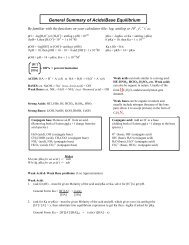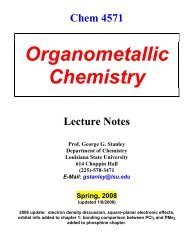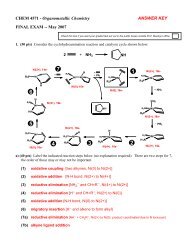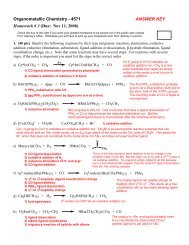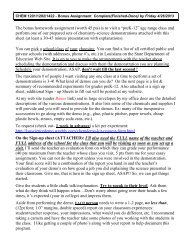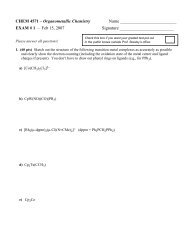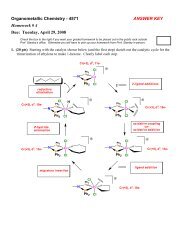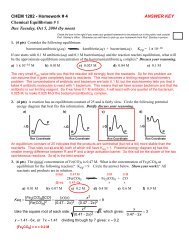Select the best answer
Select the best answer
Select the best answer
- No tags were found...
You also want an ePaper? Increase the reach of your titles
YUMPU automatically turns print PDFs into web optimized ePapers that Google loves.
3. An aqueous solution of potassium chloride, KCl, IS MIXED with an aqueous solution ofammonium sulfate, (NH 4 ) 2 SO 4 . Which one of <strong>the</strong> following represents <strong>the</strong> completemolecular equation?KCl (aq) + (NH 4 ) 2 SO 4 (aq) a. 2 KCl (aq) + (NH 4 ) 2 SO 4 (aq) K 2 SO 4 (s) + 2 NH 4 Cl (aq)b. 2 KCl (aq) + (NH 4 ) 2 SO 4 (aq) K 2 SO 4 (aq) + 2 NH 4 Cl (s)c. 2 KCl (aq) + (NH 4 ) 2 SO 4 (aq) K 2 SO 4 (s) + 2 NH 4 Cl (s)d. 2 K + (aq) + CO 3 -2 (aq) K 2 CO 3 (s)e. No reaction.4. What is <strong>the</strong> maximum number electrons allowed for <strong>the</strong> n = 3 shell?a. 6b. 8c. 16d. 18e. 245. Which of <strong>the</strong> following is <strong>the</strong> correct “Valence Shell” electron configuration for Ga, using<strong>the</strong> short hand method?a. [Ar] 4d 10 4s 2 4p 1b. [Ar] 3d 10 4s 2 4p 1c. [Ar] 3d 10 4s 2 4p 2d. [Kr] 3d 10 4s 2 4p 1e. [Ar] 4s 2 3d 10 4p 16. How any grams of B are required to produce 12 grams of C, assuming A is present in excess?a. 12 gb. 13.71 gc. 4.67 gd. 10.5 ge. 30.86 gA + 3 B 2 CCompound A B CGrams (g) -- ? 12molar mass (g/mol) 40 72 42
7. What are <strong>the</strong> spectator ions when palladium (II) oxide and nitric acid react?a. Pd +2 & NO 3-b. H + & NO 3-c. H +d. NO 3-e. None of <strong>the</strong> above8. Which one of <strong>the</strong> following sets of quantum numbers ARE ALLOWED?a. I onlyb. II onlyc. I & IV onlyd. II & III onlye. I, II & III onlyn l m lI. 2 0 2II. 3 1 -1III. 5 1 +1IV. 4 4 +29. Calculate <strong>the</strong> energy (J) for ONE quantum of electromagnetic radiation, which has awavelength of 314 nm.a. 6.93 x 10 -33 Jb. 2.08 x 10 -22 Jc. 2.08 x 10 -40 Jd. 6.33 x 10 -17 Je. 6.33 x 10 -19 J10. An aqueous solution of potassium phosphate, K 3 PO 4 , REACTS with an aqueous solution ofiron (III) nitrate, Fe(NO 3 ) 3 . Which one of <strong>the</strong> following represents <strong>the</strong> NET IONICequation for <strong>the</strong> reaction?K 3 PO 4 (aq) + Fe(NO 3 ) 3 (aq) a. K + (aq) + NO 3 - (aq) KNO 3 (aq)b. K 3 PO 4 (aq) + 2 Fe(NO 3 ) 3 (aq) Fe 2 PO 4 (s) + 3 KNO 3 (aq)c. Fe +3 (aq) + PO 4 -3 (aq) FePO 4 (s)d. 2 Fe +2 (aq) + PO 4 -3 (aq) Fe 2 PO 4 (s)e. None of <strong>the</strong> above are correct.
11. Indicate which of <strong>the</strong> following is CORRECT with regard to size and shape of an orbital andits corresponding quantum numbers, n and l:a. I onlyb. II onlyc. III onlyd. II and III onlye. All are incorrect.I. n = 1 and l = 0 represents <strong>the</strong> 1s orbitalII. n = 3 and l = 2 represents <strong>the</strong> 3p orbitalIII. n = 3 and l = 3 represents <strong>the</strong> 3f orbital12. What is <strong>the</strong> short hand electron configuration for <strong>the</strong> Cr?a. [Ar]4s 2 4d 4b. [Ar]4s 2 3d 4c. [Ar]4s 1 3d 5d. [Kr]4s 2 3d 4e. [Kr]4s 1 3d 513. A student used 22.5 mL of 0.80 M KOH to titrate 30 mL of a citric acid, H 3 C 6 H 5 O,solution. How many grams of citric acid were present in <strong>the</strong> sample?Use MM of citric acid as 192 g/mola. 1.152 gb. 3.456 gc. 10.37 gd. 0.094 ge. 8.845 g3 KOH (aq) + H 3 C 6 H 5 O (aq) K 3 C 6 H 5 O (aq) + 3 H 2 O(l)14. What is <strong>the</strong> correct “long form” electronic configuration for Fe?a. 1s 2 2s 2 2p 6 3s 2 3p 6 4s 1 3d 5b. 1s 2 2s 2 2p 6 3s 2 3p 6 4s 1 3d 7c. 1s 2 2s 2 2p 6 3s 2 3p 6 4s 2 3d 7d. 1s 2 2s 2 2p 6 3s 2 3p 6 4s 2 3d 5e. 1s 2 2s 2 2p 6 3s 2 3p 6 4s 2 3d 6
15. Based on “orbital” configuration, how many unpaired electrons are <strong>the</strong>re in <strong>the</strong> highestoccuping orbital/subshell for <strong>the</strong> chlorine atom?a. 0b. 1c. 2d. 5e. None of <strong>the</strong> above.16. Which of <strong>the</strong> following statements is (are) TRUE?I. The 1s orbital is higher in energy than <strong>the</strong> 3d orbital.II. The p orbital only has 2 orientations.III. The s orbital only has 1 orientation.a. I onlyb. II onlyc. III onlyd. I & II onlye. All are True.17. Calculate <strong>the</strong> number of milliliters (ml) that are required to contain 80 grams of chromium(III) nitrate in an 1.0 M solution.a. 367 mlb. 336 mlc. 702 mld. 354 mle. 452 ml18. Which of <strong>the</strong> following is (are) weak electrolytes in water?a. I onlyb. II onlyc. III onlyd. I & III onlye. I, III & IV onlyI. NH 3II. CO 2III. H 2 CO 3IV. HF
19. You are a student worker assigned to make solutions in <strong>the</strong> first floor stockroom of ChoppinHall for <strong>the</strong> CHEM 1212 labs. Mr. Roya Hughes needs you to make 2.0 L of0.20 M KOH solution. How many grams of KOH will you require?a. 224.4 gb. 5.610 gc. 22.44 gd. 56.10 ge. 0.045 g20. How many milliliters of 10.0 M KOH solution are required to make 1.0 liter of a 0.05 Msolution?a. 5 mlb. 200 mlc. 5 x 10 -3 mld. 1000 mle. 1 ml21. An 20 ml of unknown molarity of H 2 CO 3 requires 40 ml of an 0.1M KOH solution at <strong>the</strong>equivalence point. What is <strong>the</strong> molarity of H 2 CO 3 ?a. 1 Mb. 0.1 Mc. 0.2 Md. 0.4 Me. 3 MH 2 CO 3 (aq) + 2 KOH (aq) → K 2 CO 3 (aq) + 2 H 2 O (l)22. What is <strong>the</strong> short hand electron configuration for <strong>the</strong> As?a. [Kr]4s 2 4d 10 4p 3b. [Xe]5s 2 4d 10 4p 3c. [Ar]5s 2 4d 10 5p 3d. [Kr]4s 2 3d 10 4p 3e. [Ar]4s 2 3d 10 4p 3
23. Which orbital is described by <strong>the</strong> shape below?a. sb. pc. dd. fe. None24. What is <strong>the</strong> molecular equation for when ammonium carbonate and tungsten (IV) nitratereact?a. 2 CO 3 -2 (aq) + Ta +4 (aq) Ta(CO 3 ) 2 (s)b. (NH 4 ) 2 CO 3 (aq) + W(NO 3 ) 4 (aq) WCO 3 (s) + 2 NH 4 NO 3 (aq)c. 2 (NH 4 ) 2 CO 3 (aq) + Ta(NO 3 ) 4 (aq) Ta(CO 3 ) 2 (s) + 4 NH 4 NO 3 (aq)d. 2 (NH 4 ) 2 CO 3 (aq) + W(NO 3 ) 4 (aq) W(CO 3 ) 2 (s) + 4 NH 4 NO 3 (aq)e. None of <strong>the</strong> above.25. Who am I? This person hypo<strong>the</strong>sized that Energy must be emitted or absorbed in discretepackets or quanta and <strong>the</strong> energy for each quanta is proportional to its frequency times someconstant.a. Plankb. Einsteinc. Bohrd. Younge. Maxwell26. BONUS: There is a spill of 500 ml of 10.0 M HNO 3 ! How many grams of CaCO 3 will youneed to neutralize this spill?CaCO 3 (s) + 2 HNO 3 (aq) → Ca(NO 3 ) 2 (aq) + H 2 O (l) + CO 2 (g)a. 1 gb. 100 gc. 250 gd. 500 ge. 1000 g



